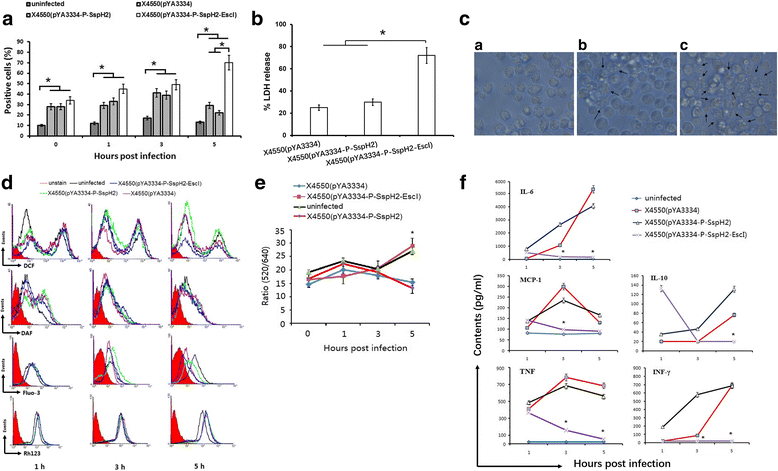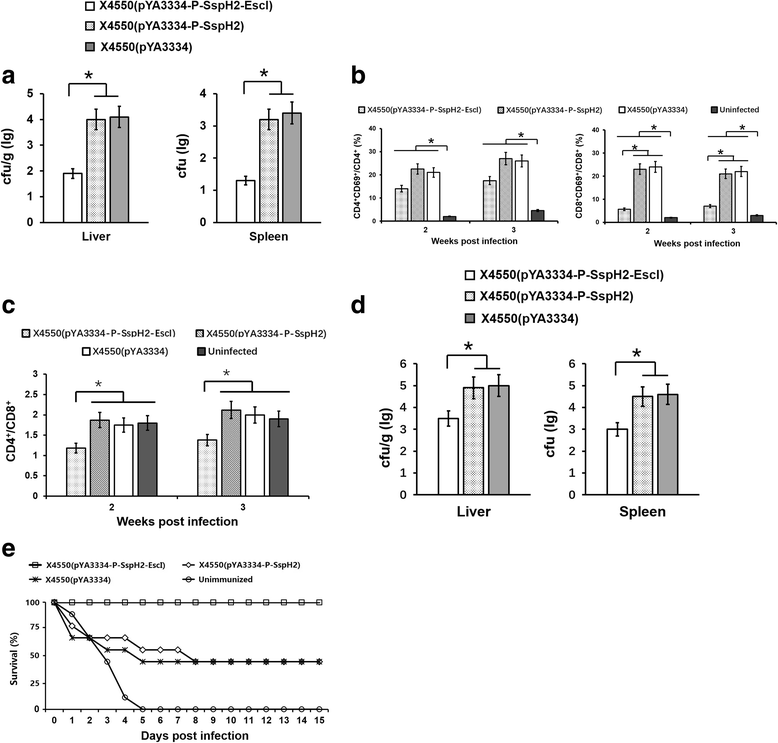Immunization with recombinant Salmonella expressing SspH2-EscI protects mice against wild type Salmonella infection
- PMID: 29523140
- PMCID: PMC5845362
- DOI: 10.1186/s12917-018-1404-5
Immunization with recombinant Salmonella expressing SspH2-EscI protects mice against wild type Salmonella infection
Abstract
Background: Enhancing caspase-1 activation in macrophages is helpful for the clearance of intracellular bacteria in mice. Our previous studies have shown that EscI, an inner rod protein of type III system in E. coli can enhance caspase-1 activation. The purpose of this study was to further analyze the prospect of EscI in the vaccine design.
Results: A recombinant Salmonella expressing SspH2-EscI fusion protein using the promotor of Salmonella effector SspH2, X4550(pYA3334-P-SspH2-EscI), was constructed. A control recombinant Salmonella expressing SspH2 only X4550(pYA3334-P-SspH2) was also constructed. In the early stage of in vitro infection of mouse peritoneal macrophages, X4550(pYA3334-P-SspH2-EscI) could significantly (P < 0.05) enhance intracellular caspase-1 activation and pyroptotic cell death of macrophages, when compared with X4550(pYA3334-P-SspH2). Except for the intracellular pH value, the levels of reactive oxygen species, intracellular concentration of calcium ions, nitric oxide and mitochondrial membrane potential in macrophages were not significantly different between the cells infected with X4550(pYA3334-P-SspH2-EscI) and those infected with X4550(pYA3334-P-SspH2). Besides, only lower inflammatory cytokines secretion was induced by X4550(pYA3334-P-SspH2-EscI) than X4550(pYA3334-P-SspH2). After intravenous immunization of mice (1 × 106 cfu/mouse), the colonization of X4550(pYA3334-P-SspH2-EscI) in mice was significantly limited at one week post immunization (wpi), when compared with X4550(pYA3334-P-SspH2) (P < 0.05). The population of activated CD8+T lymphocytes in mouse spleens induced by X4550(pYA3334-P-SspH2-EscI) was lower than that induced by X4550(pYA3334-P-SspH2) at 2-3 wpi, and the ratio of CD4+T cells to CD8+T cells decreased. The blood coagulation assay indicated that no significant difference was found between X4550(pYA3334-P-SspH2-EscI) and uninfected control, while X4550(pYA3334-P-SspH2) could induce the quick coagulation. Notably, immunization of X4550(pYA3334-P-SspH2-EscI) could limit the colonization of challenged Salmonella strains in the early stage of infection and provide more effective protection.
Conclusion: The activation of caspase-1 in macrophages by EscI can be used in the design of live attenuated Salmonella vaccine candidate.
Keywords: Caspase-1; Mice; Protection; Salmonella; SspH2-EscI.
Conflict of interest statement
Ethics approval
This study was approved by the Committee on the Ethics of Animal Experiments of Yangzhou University (Permit Number: 2007–0005). This study does not involve the use of human data or tissue.
Consent for publication
Not applicable.
Competing interests
The authors declare that they have no competing interests.
Publisher’s Note
Springer Nature remains neutral with regard to jurisdictional claims in published maps and institutional affiliations.
Figures


Similar articles
-
Recombinant Salmonella expressing SspH2-EscI fusion protein limits its colonization in mice.BMC Immunol. 2017 May 3;18(1):21. doi: 10.1186/s12865-017-0203-2. BMC Immunol. 2017. PMID: 28468643 Free PMC article.
-
Oral vaccination with attenuated Salmonella enterica serovar Typhimurium expressing Cap protein of PCV2 and its immunogenicity in mouse and swine models.Vet Microbiol. 2012 Jun 15;157(3-4):294-303. doi: 10.1016/j.vetmic.2012.01.008. Epub 2012 Jan 17. Vet Microbiol. 2012. PMID: 22326539
-
Regulated delayed attenuation improves vaccine efficacy in preventing infection from avian pathogenic Escherichia coli O78 and Salmonella typhimurium.Vet Microbiol. 2021 Mar;254:109012. doi: 10.1016/j.vetmic.2021.109012. Epub 2021 Feb 6. Vet Microbiol. 2021. PMID: 33611126
-
Salmonella type III-mediated heterologous antigen delivery: a versatile oral vaccination strategy to induce cellular immunity against infectious agents and tumors.Int J Med Microbiol. 2008 Jan;298(1-2):99-103. doi: 10.1016/j.ijmm.2007.07.002. Epub 2007 Aug 23. Int J Med Microbiol. 2008. PMID: 17719275 Review.
-
Nonrecombinant and recombinant avirulent Salmonella vaccines for poultry.Vet Immunol Immunopathol. 1996 Nov;54(1-4):365-72. doi: 10.1016/s0165-2427(96)05683-8. Vet Immunol Immunopathol. 1996. PMID: 8988881 Review.
Cited by
-
Secretory System Components as Potential Prophylactic Targets for Bacterial Pathogens.Biomolecules. 2021 Jun 15;11(6):892. doi: 10.3390/biom11060892. Biomolecules. 2021. PMID: 34203937 Free PMC article. Review.
-
Manipulation of host immune defenses by effector proteins delivered from multiple secretion systems of Salmonella and its application in vaccine research.Front Immunol. 2023 Apr 4;14:1152017. doi: 10.3389/fimmu.2023.1152017. eCollection 2023. Front Immunol. 2023. PMID: 37081875 Free PMC article. Review.
-
The Evolution of Vaccines Development across Salmonella Serovars among Animal Hosts: A Systematic Review.Vaccines (Basel). 2024 Sep 18;12(9):1067. doi: 10.3390/vaccines12091067. Vaccines (Basel). 2024. PMID: 39340097 Free PMC article. Review.
-
Dual fluorescent hollow silica nanofibers for in situ pH monitoring using an optical fiber.Nanoscale Adv. 2023 Feb 6;5(8):2180-2189. doi: 10.1039/d2na00943a. eCollection 2023 Apr 11. Nanoscale Adv. 2023. PMID: 37056611 Free PMC article.
References
MeSH terms
Substances
Grants and funding
LinkOut - more resources
Full Text Sources
Other Literature Sources
Research Materials

